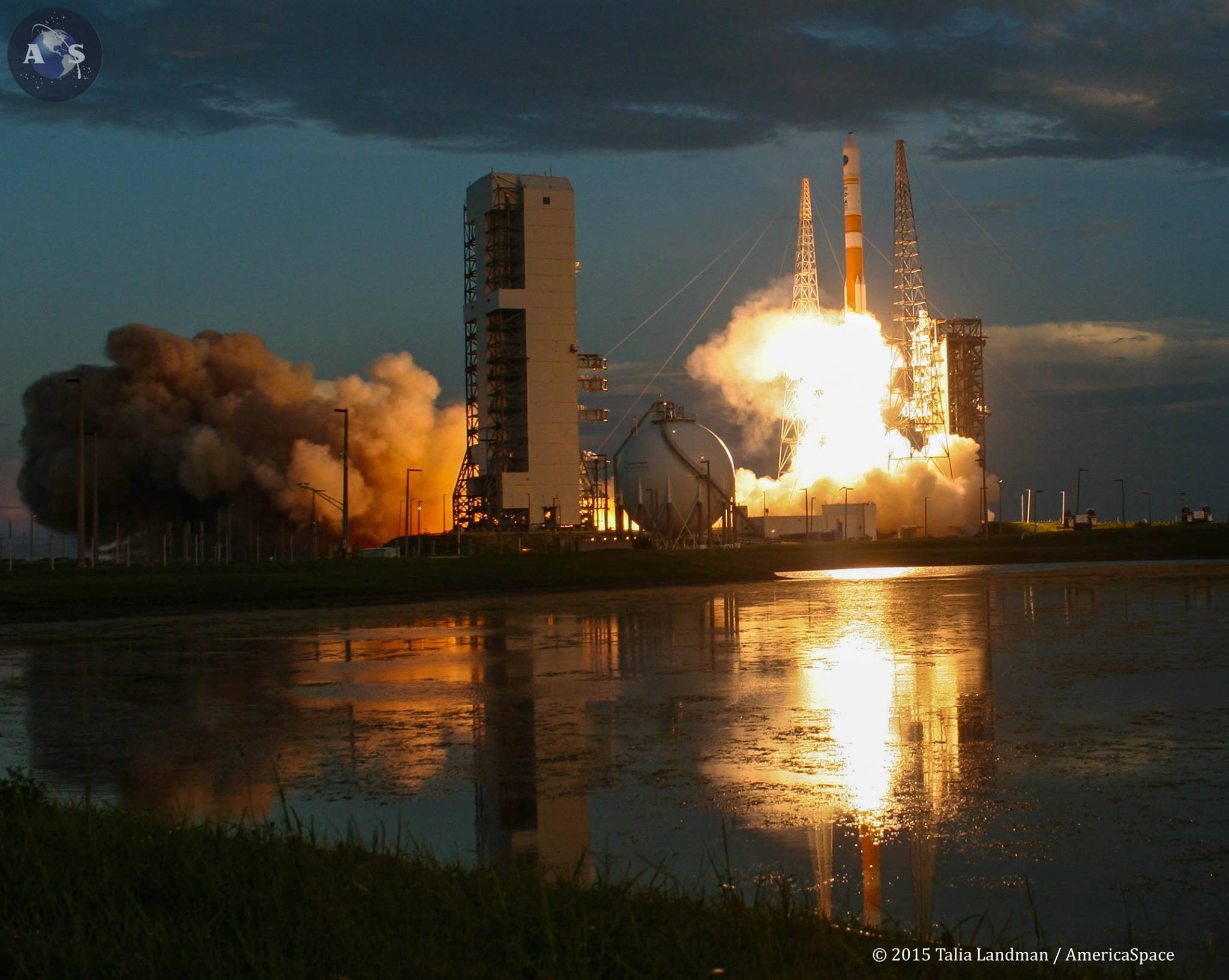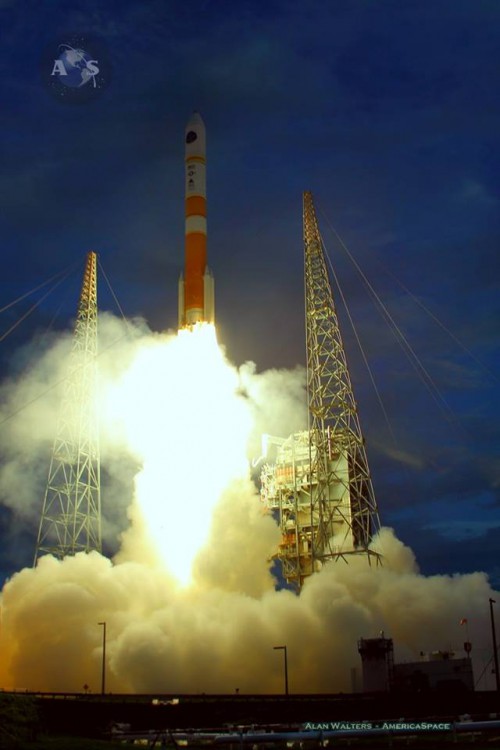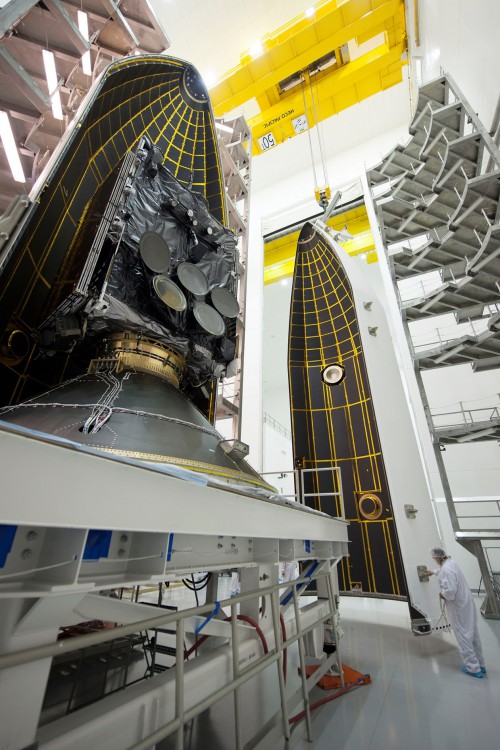
A spectacular sunset launch from Cape Canaveral by a United Launch Alliance Delta IV Medium+ rocket placed the U.S. Air Force/ Boeing WGS-7 Wideband Global SATCOM into super synchronous transfer orbit July 23, after a 24 hr. delay due to dangerous thunderstorms in the area.
The 8:07 p.m. EDT launch came at the opening of a 39 minute launch window for the mission to place WGS-7 into a 36,107 x 238 nautical mile orbit, inclined 24 degrees to the equator. The satellite’s own propulsion system will be used to lower apogee and raise perigee to about a 19,232 nautical mile geosynchronous altitude where the satellite will remain fixed over the equator at a specific location, with the rest of the WGS fleet positioned around the planet.

The USAF’s 45th Space Wing Weather Squadron worked aggressively July 23 to keep ULA apprised that approaching severe thunderstorms mandated a scrub to keep the 205 ft. launch vehicle and its $566 million satellite payload safely under cover in its mobile service tower. Then July 24 the Weather Squadron was again challenged by numerous, but weaker thundershowers around Cape Canaveral, that remained barely within limits to allow an on time rollback of the service tower and then fueling to begin 3 hours before liftoff.
According to Jim Sponnick, ULA vice president for Atlas and Delta Programs, WGS satellites are an important element of a new high-capacity satellite communications system. WGS 7 will provide enhanced communications capabilities to troops in the field for the next decade and beyond.
“WGS 7 will enables more robust and flexible execution of Command and Control, Communications, Computers, Intelligence, Surveillance and Reconnaissance (C4ISR), as well as battle management and combat support information functions” Sponnick said.
The Delta IV Medium+ (5,4) vehicle lifted off from Launch Complex 37 on 1.47 million lb. thrust, half of it provided by four Aerojet solid rocket boosters and the rest from the 702,000 lb. thrust uprated RS-68A oxygen/hydrogen engine making its debut on a Delta IV Medium.
Three RS-68As first flew in June, 2012 on the triple bodied Delta IV Heavy launch of the National Reconnaissance Office NRO-15 spacecraft to geosynchronous orbit.
NRO-15 is a massive electronic intelligence satellite with an eavesdropping antenna spanning up to 360 ft. (110 m). The uprated A version of the RS-68 was developed specifically for this mission and similar giant NRO antennas to follow. The A version will now be used on all Delta IV’s allowing ULA to standardize the assembly and internal structure of all the Common Booster Cores (CBCs) used by the launcher.
The RS-68A has 39,000 lb. more liftoff thrust than the first version of the engine that had powered all previous Delta IV missions.
The four solids separated in pairs just past the 90 sec. mark in the ascent, followed by the 5 meter faring separation past the 3 min. point. The burnout and separation of the CBC first stage occurred at 4 min into the flight.
The Delta IV’s cryogenic second stage, powered by an Aerojet Rocketdyne 24,750 lb. thrust RL10B-2 engine, was then ignited for about a 16 min. a firing that ended just off the west coast of north Africa.
The vehicle then coasted until the second stage ignited for a second time, burning 3 min. 18 sec. until 33 min. into the flight, with cutoff over south central Africa. The vehicle then coasted for 9 min. to just east of Madagascar, where the spacecraft was released 42. mi. after liftoff.
WGS-7 is the first Block II follow-on WGS spacecraft from the original 6 satellites in the WGS Block l and ll constellations.
At liftoff WGS weighed about 13,000 lb, but by the time it uses its fuel to reach its stationary orbit, spacecraft mass was down to 7,600 lbs. according to USAF Capt. Doug Downs, a WGS engineer at Los Angeles Air Force Station.

According to the Air Force, WGS-7 will support communications links in the X-band and Ka-band spectra. While Block I and II satellites can instantaneously filter and downlink up to 4.575 MHz from 39 primary channels, WGS-7 can filter and downlink up to 5.375 MHz from 46 primary channels.
As with the Block II satellites, WGS-7 includes a high-bandwidth radio frequency (RF) bypass capability, which allows for larger bandwidth allocations to users, said USAF Depending on the mix of ground terminals, data rates, and modulation and coding schemes employed, a single WGS satellite can support data transmission rates between 2.1 and 3.6 Gbps.
WGS-7 is also designed for up to ~800 MHz of additional bandwidth through the use of “Redundant Port Activation.”
WGS has 19 independent coverage areas, 18 of which can be positioned throughout its field-of-view. This includes eight steerable/shapeable X-band beams formed by separate transmit/receive phased arrays; 10 Ka-band beams served by independently steerable duplexed antennas; and one transmit/ receive X-band Earth-coverage beam. WGS can tailor coverage areas and connect X-band and Ka-band users anywhere within its field-of-view.
Five globally-located Army Wideband SATCOM Operations Centers provide 24/7 payload monitoring and command and control of the WGS constellation. Each Global Satellite Configuration and Control Element has the capability to control up to three satellites at a time.
Spacecraft platform control and anomaly resolution will be accomplished by the 3rd Space Operations Squadron at Schriever Air Force Base in Colorado Springs, CO.
According to the space engineering website Spaceflight-101 the RS-68 to RS-68A upgrade included two major design modifications. The first was a switch of the engine turbine nozzles from an axis-symmetric design to three-dimensional nozzles to reduce turbine blade loading and to expand the operational range of the LOX and LH2 turbopumps.
The site says engine specific impulse was improved by increasing the number of main injector combustion elements for better mixing and combustion efficiency. Additional upgrades made to the engine include a new bearing material that is more resistant to stress corrosion cracking.
Be sure to “Like” AmericaSpace on Facebook and follow us on Twitter: @AmericaSpace




2 Comments
2 Pings & Trackbacks
Pingback:WGS-7 on orbit | Off to the Space Races
Pingback:Weekly Links